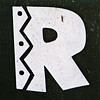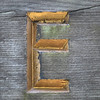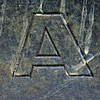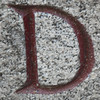This past summer I attended the American Libraries Association’s conference in New Orleans. We were the first international conference to meet in the city after Katrina. One could tell, too. The citizens were thrilled to see 17,000 extra people mulling through their shops and streets. They treated us as royalty. They were grateful we chose to visit them and spend much needed money. Not necessarily a huge amount, we are librarians after all.
One of the meetings I attended was titled “Southern Voices.” It was an opportunity for southern authors to discuss their latest books. The panel and their books included: Mark Childress and his new release One Mississippi, Tom Piazza’s Why New Orleans Matters, and Jed Horne’s Breach of Faith: Hurricane Katrina and the Near Death of a Great American City.
They were all engaging, with distinctly different voices and writing styles. One may know Mr. Childress from his book-made-into-movie, Crazy in Alabama. He read an excerpt that had us all in stitches. Mr. Piazza discussed the unique culture of New Orleans by framing the people who call it home.
The room became silent as Jed Horne took the podium. Mr. Horne’s introduction included an awe-inspiring Pulitzer Prize Award for his recent work at New Orleans Times-Picayune newspaper during Katrina. The two authors, prior to his presentation, were as rapt as the audience awaiting his speech. Mr. Horne explained that while reporting in the field he was repeatedly stopped and told harrowing stories—stories that needed to be told, but just too abundant for the newspaper’s space. He took names and numbers and when the city became relatively normal he pursued the storytellers.
Mr. Horne explained that while reporting in the field he was repeatedly stopped and told harrowing stories—stories that needed to be told, but just too abundant for the newspaper’s space. He took names and numbers and when the city became relatively normal he pursued the storytellers.
What I truly like about the book is Horne’s ability to let his subjects tell-all. He doesn’t hold back their political views and theories, which creates a sense of frustration for the reader—the same frustration one may have felt while sitting in a cozy home and watching the events unfold through the television.
Another asset Horne brings to the book is a clear understanding of local politics. As metro editor his job is to know the city’s political history. His style will thrill the reader, as he starts a story, and then slows in the middle to explain perspectives. One eagerly reads the vignettes as cliff hangers.
My Mission...Not Impossible...Make Mississippi Read!
Wednesday, August 30, 2006
Breach of Faith (copy)
Tags: Booktalk
Sunday, August 27, 2006
Avatar for Library 2.0 Class
Isaac's Storm (op-ed) OR Katrina revisited
The levees broke one year ago today in the grand city of New Orleans after Katrina swept through. Is it the levee system’s fault? After all, their construction ended in the early part of the 20th century. Is it the city leaders' fault for ignoring Hurricane Betsy's levee breach in 1965?
Is it a mistake to blame Katrina for the New Orleans devastation? Doesn't the fault live within the levee system and a government that ignores its degeneration?
The weather service did an excellent job informing the gulf areas prior to Katrina’s landfall. Katrina actually pushed through New Orleans and was heading north when the heavy winds triggered levees to collapse. Many residents still wonder what produced the loud bang before the flooding began.
Imagine the loss of life if the weather service had not warned residents. The weather service follows strict procedures when faced with potentially devastating storms. Unlike the early years when eerie calm surfs and lack of birds signaled trouble.
In 1900 the US Weather Service was a small group of observation stations around the country. Most of these stations were run by hobbyists; say a cotton farmer or sailor with a penchant for atmospheric changes. In this, loose network of amateurish professionals, observation reports sent to headquarters in Washington DC took time. The telegraph office, usually located in town, could be miles away from the observer.
The Signal Corp trained an early observer, Isaac Cline, famous for his river weather predictions in 1882. From there he advanced in the professional ranks to man the observation station on Galveston Island, Texas in 1889.
By 1900, Galveston had become the third largest port in the US. It was the first city in Texas to have electricity, a post office, a law office, a private bank and a railroad system to the mainland. It was richer and grander than Houston with a population of around 35,000.
On the morning of September 8, 1900, Buford T. Morris woke to an unusual site. “The sky seemed to be made of mother of pearl; gloriously pink, yet containing a fish-scale effect which reflected all the colors of the rainbow. Never had I seen such a beautiful sky.”
Overnight 6,000 residents of Galveston died in the “deadliest weather disaster in American history”. The category four hurricane, predicted by Isaac Cline, was also downplayed in the same breath. He believed the storm would pass north of the city and residents would be safe in their homes. A decision he would regret for the rest of his life.
The unbelievably forgotten Galveston tragedy as told in Erik Larson’ book, Isaac’s Storm: A Man, a Time and the Deadliest Hurricane in History, is eerily similar to Katrina. The storm surge on Mississippi’s gulf shores happened almost exactly as described in Galveston. The foibles of man’s risk, unchanged.
Note: Husband disagrees with said wife's opinion--Katrina is all to blame.
Saturday, August 26, 2006
What's that buzzing noise?
It bores you,
O. Henry
from
Strictly Business
Wednesday, August 23, 2006
Freckles (copy)
In the world of literature, freakish freckles, curiosity and stubbornness make for memorable characters. Pippi Longstocking, Laura Ingalls, Caddie Woodlawn and Anne Shirley are just a handful of fictional characters that spring to mind.
As an early reader, one tends to gravitate towards characters that mirror friends or one’s self. My first encounter with the be-speckled sort, arriving in book form, was Eloise. My mother and I spent hours reading this picture book front to back. Maybe because she mentioned I was very much like Eloise. 
At the time, I didn’t think she meant precocious; instead, I focused on her physical traits. Miss Eloise wasn’t a cutesy character, but an ugly, pencil-legged, big-bellied mess. Remember her freckles? Well, she only sported a few, but after Mom’s comment, my Eloise had hundreds. I knew better than mark a book; however, in my mind, she became as splotched as a speckled egg. Imagine my surprise when reading Anne of Green Gables by Lucy Maud Montgomery. The character Anne Shirley is an 11-year-old, red-headed and enormously freckled, opinionated orphan girl. She could have been my hero, had I known she existed.
Imagine my surprise when reading Anne of Green Gables by Lucy Maud Montgomery. The character Anne Shirley is an 11-year-old, red-headed and enormously freckled, opinionated orphan girl. She could have been my hero, had I known she existed.
I became familiar with Anne on a recent trip to Prince Edwards Island in Canada. As a librarian, I knew the Green Gables series, but my childhood revolved around another entertaining one, Little House on the Prairie. The kindred spirit I felt with Anne, even as an adult, was a little unexpected.
As a teacher, librarian or parent facing a reluctant reader or struggling to get a book in a child’s hand, remember this little secret—it is all in the character. This small tip is the key to creating a life-long reader. If the child identifies with a character, they tend to become the character. For example, I was crawling all over the Plaza, not Eloise.
Search out books filled with characters that mirror the young reader’s world. Take a trip to the library and check out a stack. Sit back and watch as their eyes light up when they recognize themselves. One might catch them role-playing with their imaginary, new friends.
This universal trait applies to adults, too. Adult characters may not have as many freckles, but somehow I can always tell if they did as children.
Tags: Booktalk
Sunday, August 20, 2006
Saturday, August 19, 2006
Celebrity Look-a-Like
Unique as Snowflakes
 View of Emerson's study 1877 by Florence Todd
View of Emerson's study 1877 by Florence Toddfound at Concord Museum
Wednesday, August 16, 2006
The Weather Makers (copy)
We read about it in newspapers and magazines; we hear about it from our neighbors and colleagues; we watch nature shows that include it and a former vice president lent his time to a recent movie about it. What is IT?
It is global warming and it is becoming one hot topic. A topic so hot it literally smacks you in the face when you first step outside. That is, if you believe.
While brushing my teeth before bed, I overheard David Letterman say, "This day in 1909, Antarctica was a negative 38 degrees; today it is 82 and sunny." He had just finished his monolog and was sitting at his desk when this casual comment popped out. I laughed, but then I stopped. Is this really a joke or is he telling the truth?
The South has always experienced hot, sweltering summers. This summer’s drought, the same two summers ago as 30 years ago, is normal. Heck, every mid-south farmer remembers the summers of 1988 and 1993 when we were either bone-dry or sopping wet. Heat waves, like sweet tea and watermelon, are essential elements of summer. So, if we are a little skeptical about global warming, it is understandable.
Author and scientist, Tim Flannery, claims to be a skeptic by nature about nature. He believes, “skepticism has a particularly important role to play in science, for a theory is only valid for as long as it has not been disproved.”
This is the premise of his new book, The Weather Makers. In this intense, dense book, Flannery assembles all the latest and most respected works on the subject. He then breaks the theories into three parts: reasons for the phenomenon, current effects of the phenomenon and earth’s future.
As the jacket blurb would like you to believe, we are to read the chapters through cynic eyes and make our own decisions. Unfortunately, Flannery falls short of the skeptic role, and we, as readers, lack his questioning voice. We are spoon-fed these theories as fact and expected to agree with his conclusions.
Flannery breaks his promise, but this doesn’t diminish the book’s value. He may not go about breaking myths like Myth Busters, but he does provide important information to laymen. For example, one will gain an understanding of the different methods of gauging temperatures through time. I highly recommend this book to anyone straddling the fence on this issue. Flannery successfully knocked me off.
Tags: Booktalk
Saturday, August 12, 2006
Friday, August 11, 2006
Not Picking this Battle
 I’m putting The Weather Makers down and moving on. I was planning to write favorable copy, but general opinion discourages me. Apparently, my Southern neighbors believe global warming bogus.
I’m putting The Weather Makers down and moving on. I was planning to write favorable copy, but general opinion discourages me. Apparently, my Southern neighbors believe global warming bogus.
I see their point. The South has always experienced hot, sweltering summers. This summer’s drought, the same 2 summers ago as thirty years ago, is normal. If we are truly experiencing a warming effect, it should be even hotter.
They do admit to the milder winters. It has been a good thirty years since ponds have frozen over. To Southerners, skating in your tennis shoes on the farm’s pond indicates an extra chilly winter.
I shouldn’t type cast all Southerners as non-believers. I give credit to author Tim Flannery for knocking me off the fence, having approached the issue as a skeptic. It is only through his vast research my stubborn views changed.
The book can change other Southern minds, too. I commit eagerly to book talking this honorable title, one-on-one. Using visual cues to judge my effectiveness, (like a seer) I adhere to rule number three, “Every book his reader.”
The Weather Makers (notes)
“The best evidence indicates that we need to reduce our CO2 emissions by 70% by 2050.” p6
“70 percent of all people alive today will still be alive in 2050, so climate change affects almost every family on this planet.” p7
“The CO2 from breath last week may now be feeding a plant on a distant continent, or plankton in a frozen sea. In a matter of months, all of the CO2 you just exhaled will have dispersed around the planet. Because of it dynamism, the atmosphere is on intimate terms with every aspect of our earth, from the mantle upward. No volcano belches, no ocean churns—indeed, no creature breathes—without the great aerial ocean registering it.” p22
Wednesday, August 09, 2006
French Women Don't Get Fat (copy)
What is it about diet books that make you hungry? Is it the impending deprivation between the lines? For example, my mother’s Sunday school class all gained weight when trying the Christian based diet book, Weigh Down by Gwen Shamblin. Why? Mom claims they all had a tendency to snack while reading. Usher in a new book that puts a cultural spin on weight loss. French Women Don’t Get Fat by Mireille Guiliano is your typical diet book; nothing new or earth shaking here. The common sense tips like drink plenty of water and eat smaller portions reduce weight. No mystery really, although, we secretly feel those Frenchies hoard a skinny gene from Gallic ancestors.
Usher in a new book that puts a cultural spin on weight loss. French Women Don’t Get Fat by Mireille Guiliano is your typical diet book; nothing new or earth shaking here. The common sense tips like drink plenty of water and eat smaller portions reduce weight. No mystery really, although, we secretly feel those Frenchies hoard a skinny gene from Gallic ancestors.
The book's strong point is an eye-opening glimpse into French culture. French women shop daily for fresh in-season produce and meats. French women endure many courses in one sitting by only tasting the selections and chewing slowly. Then there is the magical (natural diuretic) leek soup recipe found on page 26.
Author Giliano begins the book with her own story. At 19 she spent one year in America as a French student participating in a high school exchange program. Upon her return to France, her own father greets her with, “Tu ressembles a un sac de patates.” In English that means you look like a sack of potatoes. Quel horreurs!
Giliano claims she gained weight because of a weakness for pastries. Her solution, when face-to-face with dessert, eat a bite or two for taste and then launch into a funny story. As you deliver the punch line your company will have eaten their last morsel. Then out of politeness pass yours aside and enjoy coffee.
As in real estate, chubbiness is all a matter of, “location, location, location”. Plop a skinny French woman in Dixie and she would be chubby in a month. First, buckle her up in a car, no more walking to the market, and introduce her to fast food. Next, teach her to marinate the Southern way; bread and soak all manner of food in hot grease until golden brown. Lastly, take away her smokes, a sure 10 lb. gain. French women see cigarettes as a classic fashion accessory. The French term “le smoking” actually means dinner-jacket.
To recap, French women don’t get fat because they don’t live in the US and they probably smoke. So, don’t feel so guilty, we have more obstacles to overcome.
The book has an instant appeal for those of us that think France is so romantic. Who wouldn’t want to live like Gigi, dressed in black cigarette pants, white swingy top and black beret toting market fresh French bread, wine and flowers ala Audrey Hepburn in Sabrina through the cobbled streets of Paris.
Listen, save your money on this book and if you must read it, check it out at the library. If you are really serious about losing weight here are the keys. Drink water, exercise regularly and do not eat anything white specifically flour, sugar and salt. When you reach your target weight, eat slowly and in moderation. Vive la difference!
Tags: Booktalk
Dictionary Digs
It’s that time of year, when weary parents rejoice at the mere mention of school. The excitement abounds as the household readies for the big event. New clothes, new school supplies, even new shoes are bought for the big occasion. Did you remember the new books?
Whether off to college or to the local kindergarten, we all want our children to do their best. One key to success is a basic understanding of our native English tongue. This is why a dictionary is the single most important book in the house.
“Why, Maggie, the most important book in the house is the Bible.”
Yes, you have a point; the Bible will help all succeed spiritually. A high-quality dictionary on the other hand, will help all succeed intellectually. How many times has a word in the Bible sent you in search of a dictionary? Imagine my surprise when I looked up begot and sired while reading Genesis in sixth grade.
Dictionaries, thesauruses, encyclopedias, and familiar quotations are the cornerstones of any functional library. A good place to begin your child’s education would be with a dictionary. I suggest purchasing hardbacks for younger readers; they are usually substantial enough to withstand the bumps and bruises of play.
Merriam-Webster begins their popular dictionary series as early as preschool with the MW’s Alphabet Book or MW’s Primary Dictionary. All entries have a corresponding picture to enhance the child’s understanding of the word or concept. Another option is Dorling Kindersley’s children’s series; DK My First Dictionary or DK Illustrated Dictionary.
As your children mature, consider replacing their reference books with Merriam-Webster’s Elementary or Intermediary Dictionary. These books exclude explicit words, maintaining a G-rating. To save money, you may wish to purchase a family dictionary. In our house, we have an ancient pre-computer aged Webster, which lacks words like modem, fax and internet.
If your sons and daughters are headed off to college, 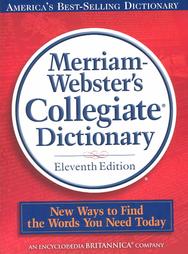 ensure they have MW’s Collegiate Dictionary. This standard, used as dorm room doorstops all over America, is now in its eleventh edition. If they request a lighter tome, Merriam-Webster offers a dictionary in MP3 format through Franklin Electronics.
ensure they have MW’s Collegiate Dictionary. This standard, used as dorm room doorstops all over America, is now in its eleventh edition. If they request a lighter tome, Merriam-Webster offers a dictionary in MP3 format through Franklin Electronics.
At the next tax-free weekend in Memphis, don’t forget the books needed to see your young scholar through preschool to their doctorate degree.
Saturday, August 05, 2006
That That (the sequel)
Seized in place, do I continue to read or gently close the book, take aim, and drive it into my green wall? Of course, I’ll continue reading, being a meek and mild librarian.
Stepping upon the soapbox—I say that that ‘that’ that that author used is wrong. What?
Another author paid to write “that that” in a sentence that needs only one. Which sentence would that be? The Weather Makers author, Tim Flannery writes, “I’m far from certain that that is true, and I’m not sure it is even relevant.” p7
Why is it that that bothers me? Well, it’s a typo that people feel might actually be right. Believe me, one will not change the meaning of the sentence by omitting an extra that.
I see these double words frequently when reading. Lots of “the the” and “and and” have me scratching my head. My Microsoft word catches these with red underscores but ignores double thats. Why is that that way?
I know that this is all irrelevant. Editors are missing the obvious “the the” combos, don’t criticize “that that,” which might be right. Here is my tiff, Flannery is wordy, and his subject at times confusing. An editor needs to weed out extra wordage to aid the reader’s time management. Took me a nanosecond to digest the “that that” but a good 30 minutes to get over it!
Sighing as I step off the soapbox.
Wednesday, August 02, 2006
Is it hot out here?
The Mermaid Chair (copy)
 What do you do when your mother does something exceptionally weird? So weird in fact you are thinking of having her committed. I mean, even at her best, she always seems to stand on shifting sand.
What do you do when your mother does something exceptionally weird? So weird in fact you are thinking of having her committed. I mean, even at her best, she always seems to stand on shifting sand.
My mother, Nelle Dubois, wasn’t always this way. Before she lost her husband, she never missed a picnic or clambake. She would be the first in the water when tide was out and the last to leave the annual Mermaid Festival parade. Now she spends her time in religious ceremonies, constant rosary chants and cooking meals for the island’s Benedictine monastery.
It hasn’t always been easy, being the daughter of one so morose. Before Dad’s tragic accident, I could tell she loved me, although a little removed. It was my father that doted on me. He would sing my name Jessie Jessie Jessie as he barreled through the front door after work. I was so special to him; he even named his boat after me, Jes-Sea.
Maybe this island has driven her to do such a horrible thing. Some crazed island fever, like cabin fever, the same fever which drove her to bury an old tub in the front yard. Just halfway that is, so she could place Mother Mary inside and plant flowers all around—an icky grouted grotto, for all to admire.
Possibly the people themselves have led to Mother’s derangement. Can you believe our little island has a mermaid saint? Something the tourists just eat up. I mean, slap a mermaid on it and its gold. The island is literally littered with hundreds of yellow signs stating, “Mermaid Xing.”
We call her Saint Senara, and every April 30, we carry her throne through the sandy lanes of Egret Island. On the backs of celibate monks, aloft for all to see, breast of mermaids swaying in the island heat. Maybe the whole island nation could use a little time in a padded cell. Might be something the monks could rent out for income.
I mean to say, this is how I left the island 23 years ago. I left golf cart commuters, slave cemetery viewers, and mermaid lovers behind—far behind, until the implausible late night call. My mother, saints preserve us or should I say mermaids preserve us, is less one finger. It seems she voluntarily, without accident, donated a digit to the Lord during her nightly monastery cooking.
Southern author Sue Monk Kidd of The Secret Life of Bees improves upon her craft with second book The Mermaid Chair, packed with love, mystery, and candid meaning.
Maggie's Note: I'm taking on the persona of main character Jessie Sullivan. These words are my choice and not cited from the book.
Tags: Booktalk
Tuesday, August 01, 2006
What are your things?
~Sue Monk Kidd
The Mermaid Chair

